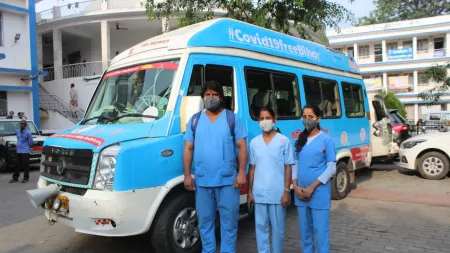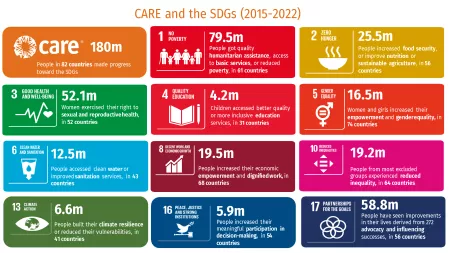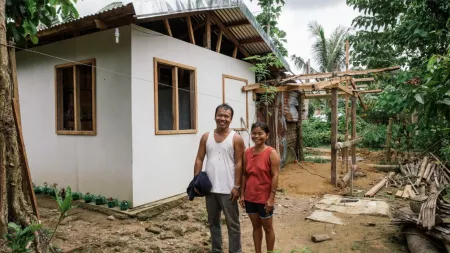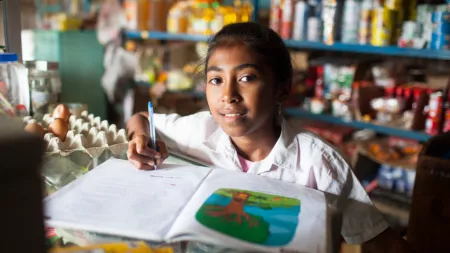Since 2015, when the Sustainable Development Goals first launched, 180 million people have made progress toward those goals with support from CARE and our partners. What does 180 million people mean?
Among other things, it’s equivalent to 8.4% of all the people who were living in poverty (less than $3.65 per day) in 2015.
It’s also more than the entire population of Bangladesh, or a little under half the population of the United States if those are more helpful benchmarks.
Think for a minute about the scope of the response that implies. In 2022, we reached 7% of the people in humanitarian need. Since the SDGs launched, 180 million people have seen measurable progress towards at least one sustainable development goal, 8.4% of the people that the SDGs are supposed to serve. That’s an incredible impact, and it’s all the more meaningful because it spans both humanitarian response and long-term change.
CARE has been measuring impact against the SDGs since 2015, and we’re one of the only NGOs in the world to do so. That impact backed up by tangible evidence of a change in someone’s life—not just the activity they took part in, but also the difference it made for them. That impacts span a range of changes
Maybe that’s the 1.6 million women and girls who participated in decisions in a new way they couldn’t before. Maybe it’s the 1.1 million women who can meet their family planning needs. Maybe it’s the 2 million people who have safe water to drink in a humanitarian crisis. Maybe it’s the 1.3 million people who are more resilient to climate change because they are taking new steps. Maybe it’s the 14.4 million people who have access to financial services through VSLAs. Taken together, it’s a picture of powerful change that is possible when CARE works with partners and people to make progress.

What progress have people made?
- 79.5 million people have gotten quality humanitarian assistance, reduced poverty, or gotten access to basic services. That includes 10.3 million people in Yemen who got cash, improved hygiene or access to clean water. It also includes more than 300,000 people in Sudan who found ways to cope with COVID, including better water and better nutrition with support from CARE and partners. In Ethiopia’s Berchi project, those impacts on food and poverty kept growing, even 6 years after the project closed. (SDG 1)
- 25.5 million people have more food, better nutrition, or better agricultural production. That includes 1.6 million people in Nepal who improved their food security, through participatory social accountability approaches. (SDG 2)
- 52.1 million women have better sexual and reproductive health. That includes 7.8 million couples in Bangladesh who got modern contraceptives from NGO service delivery partners. (SDG 3)
- 4.2 million children have better or more inclusive education. That includes 420,000 kids in Timor Leste who got quality education materials, even during COVID. (SDG 4)
- 16.5 million women and girls increased their empowerment and gender equality. That includes 1.6 million women and girls who are participating in decision-making in ways they didn’t before. It also is 200,000 women in Niger who are changing the rules of leadership and public participation, and the millions of women in VSLAs who participate more because of the solidarity and confidence VSLAs make possible. (SDG 5)
- 12.5 million people accessed clean water or better sanitation. For example, 5.8 million people in Peru got access to better water and sanitation services. In Zimbabwe, 79% of families still had clean water 4 years after the project ended. (SDG 6)
- 19.5 million people had more economic empowerment or dignified work. In the Philippines, women entrepreneurs still saw increased incomes, even seven years after Typhoon Haiyan. (SDG 8)
- 19.2 million people have more equal lives. 500,000 women in Rwanda are taking advantage of closing the financial inclusion gap. For example, the Domestic Workers’ program in Latin America helped 143,000 increase their awareness of rights or access services. (SDG 10)
- 6.6 million people have built their resilience to climate change. That includes 756,000 people in Madagascar who have increased resilience. (SDG 13)
- 5.9 million people are participating in public decision-making. For example, in Ghana we helped increase meaningful participation in local government decision-making for 2.4m people. (SDG 16).
- 58.9 million people have better lives because of better policies. 272 advocacy successes in 56 countries are leading to better lives for people around the world.

How did it happen?
- Build evidence for equality. Burundi’s Win-Win project showed that focusing on gender equality in agriculture increases in rice production, food security, and incomes, as well as feelings of safety and attitudes rejecting gender-based violence. The approach produced a return of $5 for every $1 invested, compared to a $3 return from a gender mainstreaming approach that just shared messages on gender equality.
- Support women leaders and organizers. Made by Women has enabled 217,000 women garment factory workers in Asia to claim their rights or reduce risk of sexual harassment in the workplace, and a further 4.1m stand to benefit from improved legal practices CARE and our partners have influenced. 300 factories have worked with CARE to make changes to their policies, systems, and workplace cultures.
- Get EVERYONE to fight gender based violence. With our local partners RWAMREC and RWN in the Indashyikirwa project in Rwanda, a couples’ curriculum program contributed to a 55% reduction in the odds of women experiencing physical and/or sexual intimate partner violence (IPV). Amongst men, the curriculum led to a 47% reduction in the odds of reporting having perpetrated physical and/or sexual IPV.
- Strengthen national systems. The Bihar health program in India has improved health services for 30.8 million women and children, strengthening capacities of the government health system. Use of modern contraceptives increased from 44.5% to 77.8%, and the proportion of births attended by skilled health personnel increased from 68.4% to 79.2%.
- Advocate for global systems change. CARE and allies successfully advocated for an additional $1bn in US Government global humanitarian funding for famine relief, providing assistance to 20-30m people a year starting in 2018.
Want to learn more?
Check out this year’s report on CARE and the SDGs.

